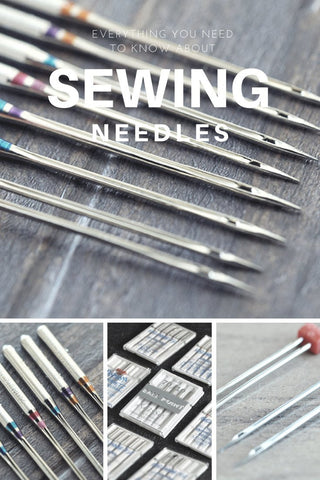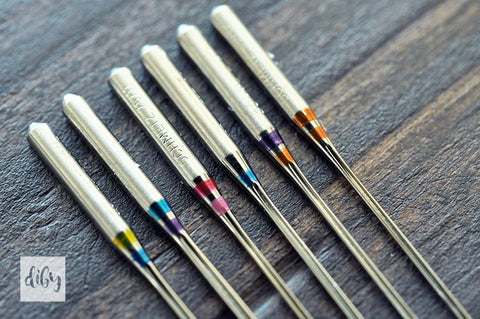
All About Sewing Machine Needles
, by Holly Hetzner, 8 min reading time

, by Holly Hetzner, 8 min reading time
Ok, so you’re all in on this whole “sew my own stuff” thing that all the cool kids are doing, right? You get a machine, or maybe your mother-in-law offered you her old one because it’s been collecting dust since the late 50’s. You head to the store to pick up some fabric, thread and – “what the heck are all of these needles”!
Ok, so you’re all in on this whole “sew my own stuff” thing that all the cool kids are doing, right? You get a machine, or maybe your mother-in-law offered you her old one because it’s been collecting dust since the late 50’s. You head to the store to pick up some fabric, thread and – “what the heck are all of these needles”! Universal, ballpoint, Microtex, oh my! And like most, you probably just grabbed a Universal because “it’s universal” ammiright?
Well, I’m here to show you a brighter path, my friend. While all of the different needle types, colors and numbers may seem confusing at first, this article will get you “ship shape and seaworthy” as Jake and the Neverland Pirates would say to my 5-year-old. (#idonthaveadultconversationsanymore)

The first thing you may be looking at is the type of needle. Pictured below are Microtex sharp, denim, embroidery, ballpoint, universal, jean, stretch and twin needles.

There are a handful of other types of needles so let’s just clear the air here and cover exactly what each is used for:
Universal
I put this one first because it’s the one everyone has used. “Middle of the road” on most needle attributes. A universal needle is sharp enough to penetrate most woven fabrics but has the slightest ballpoint so it can be used with knits as well. The problem is that since it is in the “middle” for sharpness it is known for causing damage to some knit fabrics. This can cause your seams to tear at the stitch. And since it has a slight ballpoint it is not suitable for many heavier wovens and can jam during construction or cause skipped stitches. It is best used with lightweight wovens and can also be used with more open weaved knit fabrics.
Ballpoint/Jersey
Ballpoint needles have a rounded tip. This allows the needle to slip between the fibers of knitted fabrics. If the tip was sharp it would tear through them instead. If you are sewing a knit fabric, you will want to use a ballpoint – also known as a jersey – needle. Ballpoint needles are obviously a poor choice for any woven fabrics as they are not able to cut through the weave and will inevitably result in curse words at your sewing machine.
Denim
Denim needles have a sharper tip than Universal needles. This helps them cut through heavy woven fabrics such as denim and corduroy. If you find that your Universal needle is having a hard time pushing through your heavy woven fabric, you may want to opt for a denim needle instead.
Double Needle/Twin Needle

Twin needles are a wonderful addition to any garment sewist’s tool box. They are two parallel needles connected at the base of a single shaft. They are available in both Universal and Ballpoint varieties and in multiple widths. They are used primarily for topstitching as they create two parallel rows of stitches. Straight stitches made with twin needles also have more stretch to them than a single needle straight stitch which makes them preferred for topstitching knit fabrics. If you don’t know how to use a twin needle, you can find everything you’d need to know about them in this tutorial.
Embroidery
Embroidery needles a characterized mainly by their unique scarf and eye. The scarf is smoother and the eye is larger. This creates less friction on the thread than other types of needles which protects your specialty embroidery thread.
Leather
There are many, many different kinds of leather hand needles. The kind you put in your sewing machine will be sharper than Universal or Denim needles and are a bit narrower to cut through leather and other non-woven materials with ease.
Microtex Sharp
This needle is the sharpest of them all. It is very delicate and needs to be replaced more often than other types of needles. It creates beautifully straight and precise stitches. It is great for edge stitching or topstitching microfiber materials and other high thread count fabrics. It should not be used for heavy materials.
Stretch Needle
Stretch needles are a type of ballpoint needle. They have a narrower ballpoint to them than the traditional ballpoint/jersey needle. This makes them somewhat of a cross between a jersey and universal needle. They are shaped like this to help prevent skipped stitches while sewing highly elastic fabrics such as scuba, techno, swimknit, etc. They need a rounded tip to prevent damage to the fabric, but they need to be sharp enough to penetrate the elasticity in these fabrics.
Topstitching Needle
Topstitching thread is thicker than all-purpose thread. A topstitching needle has a larger eye to accommodate the thicker thread. Most other needle types are usable for topstitching thread, but if you’re finding that a particular specialty thread is getting too much drag from your needle, you may want to use a topstitching needle instead.
So let’s throw that all together into a pretty chart shall we?
| Type | Good For |
|---|---|
| Universal | Light to medium weight woven and more open weaved knits like sweaterknits |
| Ballpoint/Jersey | Most knit fabrics such as cotton lycra and french terry |
| Denim | Heavy weight woven fabrics such as denim and corduroy |
| Double Needle/Twin Needle | Topstitching – available in multiple widths and types |
| Embroidery | Embroidery projects |
| Leather | Leather and other non-woven synthetics such as plastic and vinyl |
| Microtex Sharp | Lighterweight high thread count materials such as satin or microfiber |
| Stretch | High elastic fabrics such as scuba and swimknit |
| Topstitching | Topstitching with very thick specialty threads |
The next thing you’ll likely notice about the needle packages are all of those numbers.

These numbers are measurements for the needle size. When you see two numbers next to one another you are likely viewing the metric and United State standard sizes for that needle. The larger number is the metric size which is the width in millimeters multiplied by 100. Metric sizes range between 60 and 120. The other number is the US needle size which ranges from 8 to 19. The larger the number, the larger the needle.
The other code you may find on your machine needle package is “130/705 H”. This refers to the system this needle should be used for. In this case, a home sewing machine. Needles used in industrial sewing machines have a shank and scarf designed for those systems.
The last thing to point out are the colors found along the shaft of the needle.

These colors are unique to each brand and usually refer to the type and size of the needle. Singer, Kenmore, Schmetz, etc. will all have their own color coding system. Schmetz is a leader in the needle space here in the United Stated, however, so I will cover their color code.
The top color on a Schmetz needle refers to the needle type and the bottom color refers to the needle size. This makes sorting through loose needles a breeze! Why does Jessica have loose needles lying around? Well, first of all, they aren’t lying around willy-nilly mmkay? Second of all, I frequently swap out needles in all three of my machines (sewing machine, serger and coverstitch machine) depending on what fabric I am sewing with. And so should you! This means you’ll have a pretty little pile of good needles you rotate through frequently and understanding the color code, makes it no big deal.
Use Schmetz needles like me? Check out the color code chart below:

That’s all folks! I bet you feel pretty smart right now. You have transcended from “Universal needle beginner” to “sewing needle aficionado” just like that. So what are your tips and tricks for picking the right needle? Leave your comments below!